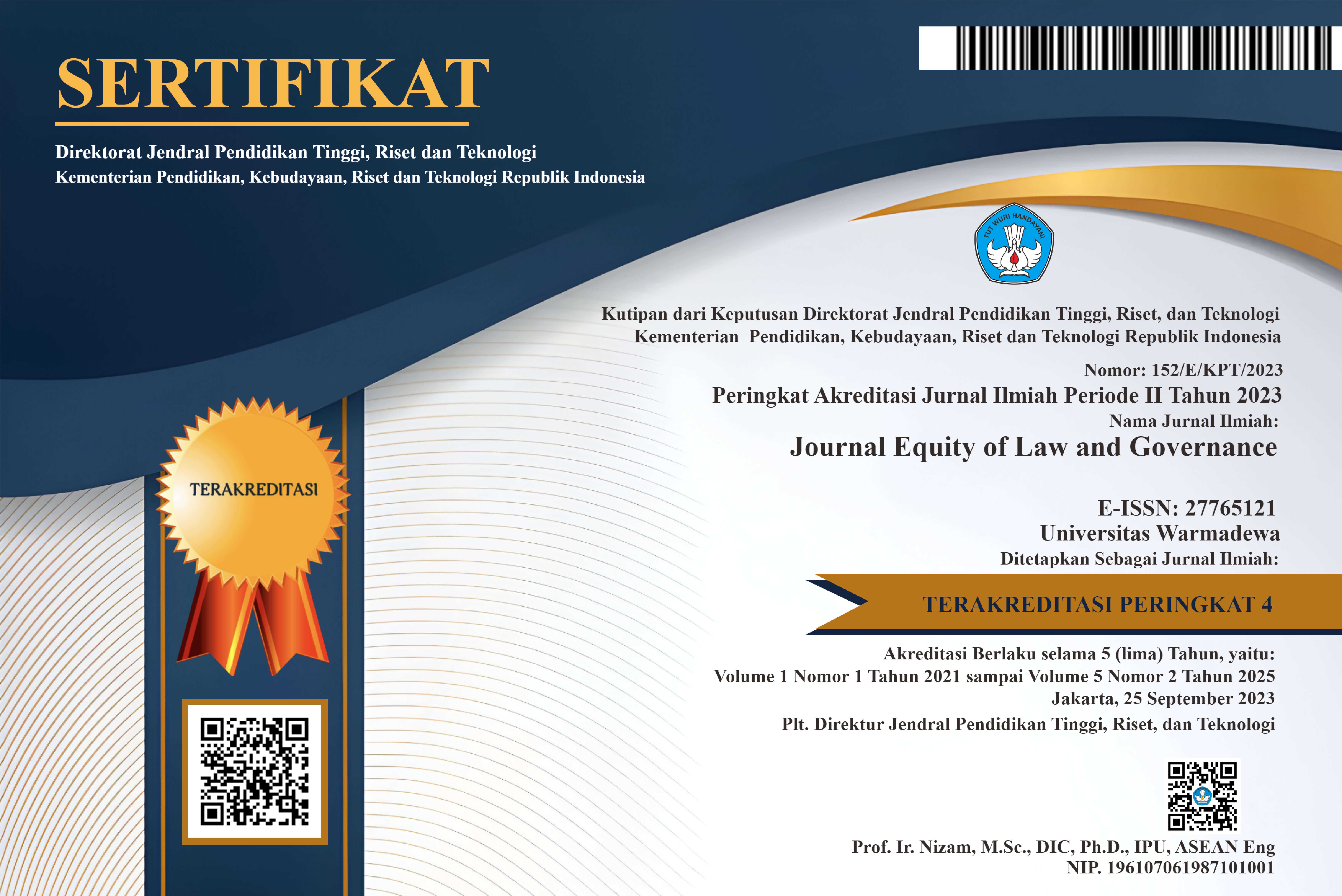The Analysis of the Demographic Bonus Law on Improving Company Employment Relations
Abstract
Every country has a different population. Residents are all people who live in the territory of a country for six months or more and stay temporarily or permanently for different purposes. Population is very important to support the activities of a country, including to improve the performance of the area where the population lives. The existence of the population is also very important in carrying out a company's performance activities, especially in the implementation of labor relations... At the time of
the Demographic Bonus, the age of the productive population dominates compared to the age of the unproductive population. The Demographic Bonus, also known as the "demographic dividend," refers to a period of economic growth that can occur when a country's working-age population (15-64 years old) is larger than the dependent population (children and the elderly). This demographic structure creates a window of opportunity for accelerated economic development because there are fewer dependents to support, allowing for greater investment in education, healthcare, and infrastructure.This research aims to analyze and examine Indonesia's readiness to face the demographic bonus as well as Indonesia's strategy to become a developed country through the momentum of the Demographic
Bonus. Based on current data and conditions, Indonesia still needs to prepare everything including strategies that support its progress and avoid everything that brings Indonesia closer to its decline, especially during the Demographic Bonus momentum.
References
A.S., A. (1977). Some Aspects of Regional Growth and Development Theories. Akademika: Journal of
Humanities and Social Science. Natiional University of Malaysia.
Achmad Nur Sutikno. (2020). Bonus Demografi Di Indonesia. VISIONER: Jurnal Pemerintahan Daerah
Di Indonesia, 12(2), 421–439. https://doi.org/10.54783/jv.v12i2.285
Binsar Jon Vic S. (2023). Challenges Facing Soes and Soe Subsidiaries Toward Business
Tranformation Law Enforcement and Human Rights Protection (Post Constitutional Court
Decision Number 01/PHPU-PRES/XVII/2019). Journal Equity of Law and Governance, 3(1), 13–16. https://doi.org/10.55637/elg.3.1.6605.13-16
Falikhah, N. (2017). Bonus Demografi Peluang Dan Tantangan Bagi Indonesia. Alhadharah: Jurnal
Ilmu Dakwah, 16(32). https://doi.org/10.18592/alhadharah.v16i32.1992
Jati, W. R. (2015). BONUS DEMOGRAFI SEBAGAI MESIN PERTUMBUHAN EKONOMI: JENDELA
PELUANG ATAU JENDELA BENCANA DI INDONESIA? Jurnal Populasi Universitas Gadjah Mada, 23(1), 1–19.
KEMNAKER. (2021). Kondisi Ketenagakerjaan di Indonesia Tahun2021-2023.
https://satudata.kemnaker.go.id/
Mardhiyah, R. H., Aldriani, S. N. F., Chitta, F., & Zulfikar, M. R. (2021). Pentingnya Keterampilan Belajar
di Abad 21 sebagai Tuntutan dalam Pengembangan Sumber Daya Manusia. Lectura Jurnal
Pendidikan, 12(1), 29–40. https://doi.org/https://doi.org/10.31849/lectura.v12i1.5813
Martias, F. M. (2022). Dampak Kebijakan Tenaga Kerja Asing Era Pemerintahan Joko Widodo (2014–
terhadap Tenaga Kerja Lokal di Indonesia. Jurnal PolGov, 4(1), 67–123.
https://doi.org/10.22146/polgov.v4i1.3774
Masniadi, R. (2012). Analisis Pengaruh Jumlah Penduduk, Tabungan, Dan Investasi Terhadap Tingkat
Pendapatan Per Kapita Indonesia. Jurnal Ekonomi Pembangunan, 10(1), 69.
https://doi.org/10.22219/jep.v10i1.3718
Ramdhani, A. R. M. A. (2016). Konsep Umum Pelaksanaan Kebijakan Publik. Jurnal Publik, Vol 11(January), 1–12. https://journal.uniga.ac.id/index.php/JPB/article/download/1/1
Roestamy, M., Suhartini, E., & Yumarni, A. (2020). Metode, Penelitian, Laporan dan Penulisan Karya
Ilmiah Hukum Pada Fakultas Hukum (4th ed.). Fakultas Hukum Universitas Djuanda.
Sindhu P, Y. (2016). GEOGRAFI (Hadiyansyah (ed.)). Penerbit Erlangga.
Statistik, B. P. (2022a). Badan Pusat Statistik, Rata-rata Kebutuhan Hidup Layak (KHL) Pekerja Lajang
(PL) 2019-2021. https://www.bps.go.id/indicator/19/1521/2/rata-rata-upah-gaji.html
Statistik, B. P. (2022b). Rata-Rata Upah/Gaji (Rupiah) 2019-2021.
https://www.bps.go.id/indicator/19/1521/2/rata-rata-upah-gaji.html
Suhartini, E. (2020). Hukum Ketenagakerjaan Dan Kebijakan Upah. Rajawali Pers.
Suhartini, E., Hartiwiningsih, Handayani, I. G. A. K. R., & Roestamy, M. (2019). LEGAL POLITICS AND
POLICY SETTING OF WAGE SYSTEMS FOR CREATING SOCIAL JUSTICE OF WORKERS. Journal of Legal, Ethical and Regulatory Issues, 22(6), 1–7.
Suhartini, E., Zaini, M. F., Widjojanto, B., & Yumarni, A. (2023). Indonesian Migrant Workers After Job
Creation Law: A Challenging Problem for Protection Welfare. BESTUUR, Vol. 11(02), 271–289.
Tobing, G. L. (2015). Korelasi Antara Ketersediaan Lapangan Kerja, Sistem Pengupahan Dan
Pekerjaan Sektor Informal. To-Ra, 1(2), 129. https://doi.org/10.33541/tora.v1i2.1142
Widiansyah, A. (2017). Peran ekonomi dalam pendidikan dan pendidikan dalam pembangunan
ekonomi. Cakrawala-Jurnal Humaniora, 17(2), 207–215.
Zulham, T., & Basyiran, T. B. (2015). BONUS DEMOGRAFI DI KOTA BANDA ACEH: PELUANG DAN
TANTANGAN KETENAGAKERJAAN. Jurnal Demografi Aceh, Vol. 2., 23–47.
 Abstract viewed = 66 times
Abstract viewed = 66 times
 PDF downloaded = 43 times
PDF downloaded = 43 times













